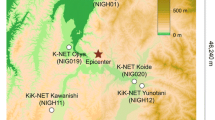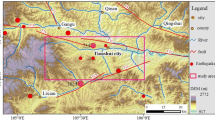Abstract
Seismically triggered landslides can cause great damage to the road construction in mountainous areas. The permanent displacement analysis based on Newmark sliding-block model can evaluate risk of these landslides from the perspective of deformation damage and overall failure probability of slopes. However, the sliding-block model does not consider the attenuation effect of the shear strength on the sliding surface during earthquake, causing the calculated value of Jibson method to be less than the actual value. Therefore, the Newmark model was modified by adding attenuation coefficients to the effective internal friction angle and the effective cohesion of geologic units. The landslide areal density was proposed for hazard zoning with the Wenchuan earthquake data. The results showed that the predicted values agreed well with the real distribution of the landslides triggered by the Lushan earthquake. The proposed hazard zoning method in this paper can predict the severity of seismic landslides in consideration of the environmental changes in mountainous regions after the earthquake and provide support for the site selection in highly seismic areas.











Similar content being viewed by others
References
Al-Homoud AS, Tahtamoni W (2000) Comparison between predictions using different simplified Newmarks’ block-on-plane models and field values of earthquake induced displacements. Soil Dyn Earthq Eng 19:73–90
Ambraseys NN, Menu JM (1988) Earthquake-induced ground displacements. Earthq Eng Struct Dyn 16:985–1006
Ambraseys NN, Srbulov M (1994) Attenuation of earthquake-induced displacements. Earthq Eng Struct Dyn 25:467–487
Bray JD, Travasarou T (2007) Simplified procedure for estimating earthquake-induced deviatoric slope displacements. J Geotech Geoenviron Eng 133:381–392
Chen QG, Ge H, Zhou HF (2011) Mapping of seismic triggered landslide through Newmark method: an example from study area Yingxiu. Coal Geol China 11:44–48 (in Chinese)
Cui P, He SM, Yao LK (2011) Formation mechanism and risk control of mountain disaster in Wenchuan earthquake. The Science Publishing, Beiging, pp 102–103 (in Chinese)
Decanini LD, Fabrizio M (2001) An energy-based methodology for the assessment of seismic demand. Soil Dyn Earthq Eng 21:113–137
Duan SS, Yao LK, Guo CW (2015) Predominant direction and mechanism of landslides triggered by Lushan earthquake. J Southwest Jiao Tong Univ 3:428–434 (in Chinese)
Gorum T, Fan XM, van Westen CJ, Huang RQ, Xu Q, Tang C, Wang GH (2011) Distribution pattern of earthquake-induced landslides triggered by the 12 May 2008 Wenchuan earthquake. Geomorphology 133(3–4):152–167
Huang RQ, Li WL (2008) Research on development and distribution rules of geohazards induced by Wenchuan earthquake on 12th May, 2008. Chin J Rock Mech Eng 12:2585–2592 (in Chinese)
Huang Y, Xiong M (2017) Dynamic reliability analysis of slopes based on the probability density evolution method. Soil Dyn Earthq Eng 94:1–6
Huang Y, Hu HQ, Xiong M (2018) Probability density evolution method for seismic displacement-based assessment of earth retaining structures. Eng Geol 234:167–173
Jaeger JC, Cook NGW (1969) Fundamentals of rock mechanics. Methuen and Company, London, p 513
Jibson RW (1993) Predicting earthquake-induced landslide displacements using Newmark’s sliding block analysis. Transp Res Rec 1411:9–17
Jibson RW (2007) Regression models for estimating coseismic landslide displacement. Eng Geol 91:209–218
Jibson RW, Keefer DK (1993) Analysis of the seismic origin of landslides: examples from the New Madrid seismic zone. Geol Soc Am Bull 105:521–536
Jibson RW, Harp EL, Michael JA (2000) A method for producing digital probabilistic seismic landslide hazard maps. Eng Geol 58(3–4):271–289
Keefer D (2000) Statistical analysis of an earthquake-induced landslide distribution: the 1989 Loma Prieta and California event. Eng Geol 58(3–4):231–249
Keefer DK, Wilson RC (1989) Predicting earthquake-induced landslides, with emphasis on arid and semi-add environments. Landslides Semi Arid Environ 2:118–149
Khazai B, Sitar N (2000) Assessment of seismic slope stability using GIS modeling. J Appl Physiol 6:121–128
Kokusho T, Ishizawa T (2006) Energy approach for earthquake induced slope failure evaluation. Soil Dyn Earthq Eng 26:221–230
Kokusho T, Ishizawa T, Nishida K (2009) Travel distance of failed slopes during 2004 Chuetsu earthquake and its evaluation in terms of energy. Soil Dyn Earthq Eng 29:1159–1169
Lee CT, Hsieh BS, Hsuan C (2012) Regional arias intensity attenuation relationship for Taiwan considering V s30. Bull Seismol Soc Am 102:129–142
Ling HI, Le D, Chou NS (2001) Post-earthquake investigation on several geosynthetic-reinforced soil retaining walls and slopes during the Ji–Ji earthquake of Taiwan. Soil Dyn Earthq Eng 21:297–313
Ling HI, Liu H, Mohri Y (2005) Parametric Studies on the Behavior of Reinforced Soil Retaining Walls under Earthquake Loading. J Eng Mech 131(10):1056–1065
Lveda SAS, Murphy AW, Jibson RW (2005) Seismically induced rock slope failures resulting from topographic amplification of strong ground motions: the case of Pacoima Canyon, California. Eng Geol 80:336–348
Ma SY, Xu C (2018) Assessment of co-seismic landslide hazard using the Newmark model and statistical analyses: a case study of the 2013 Lushan, China, Mw6.6 earthquake. Nat Hazards 96:389–412. https://doi.org/10.1007/s11069-018-3548-9
Milesa SB, Ho CL (1999) Rigorous landslide hazard zonation using Newmark’s method and stochastic ground motion simulation. Soil Dyn Earthq Eng 18:305–323
Newmark NM (1965) Effects of earthquakes on dams and embankments. Geotechnique 15:139–160
Rajabi AM, Mahdavifar MR, Khamehchiyan M, Gaudio VD (2011) A new empirical estimator of coseismic landslide displacement for Zagros Mountain region (Iran). Nature Hazards 59:1189–1203
Rodriguez C, Bommer J, Chandler RJ (1999) Earthquake-induced landslides: 1980–1997. Soil Dyn Earthq Eng 18:325–346
Rodríguez-Peces MJ, García-Mayordomo J, Azañón JM (2014) GIS application for regional assessment of seismically induced slope failures in the Sierra Nevada Range, South Spain, along the Padul fault. Environ Earth Sci 72:2423–2435
Romeo R (2000) Seismically induced landslide displacements: a predictive mode. Eng Geol 58:337–351
Shang YH, Lee CT (2011) Empirical estimation of the Newmark displacement from the Arias intensity and critical acceleration. Eng Geol 122:34–42
Wang JC, Zao MJ, Chen W, Wang K (2012) Comparison of dynamic and static triaxial test on the soil-rock mediums. Adv Mater Res 446–449:1563–1567
Wang T, Wu SR, Shi JS, Xing P (2013) Case study on rapid assessment of regional seismic landslide hazard based on simplified Newmark displacement model: Wenchuan as 8.0 earthquake. J Eng Geol 1:16–24 (in Chinese)
Wieczorek GF, Wilson RC, Harp EL (1993) Map showing slope stability during earthquakes in San Mateo County, California. Metall Mater Trans A 681:155–164
Wilson RC, Keefer DK (1985) Predicting areal limits of earthquake induced landsliding. Geol Surv Prof Pap 1360:317–345
Xu C, Xu XW, Yao X, Dai FC (2014) Three (nearly) complete inventories of landslides triggered by the May 12, 2008 Wenchuan Mw 7.9 earthquake of China and their spatial distribution statistical analysis. Landslides 11(3):441–461
Yin YP, Wang FW, Sun P (2009) Landslide hazards triggered by the 2008 Wenchuan earthquake, Sichuan, China. Landslides 6(2):139–152
Acknowledgements
This study was supported by the National Natural Science Foundation of China (41530639 and 41571004).
Author information
Authors and Affiliations
Corresponding author
Additional information
Publisher's Note
Springer Nature remains neutral with regard to jurisdictional claims in published maps and institutional affiliations.
Rights and permissions
About this article
Cite this article
Jin, K.P., Yao, L.K., Cheng, Q.G. et al. Seismic landslides hazard zoning based on the modified Newmark model: a case study from the Lushan earthquake, China. Nat Hazards 99, 493–509 (2019). https://doi.org/10.1007/s11069-019-03754-6
Received:
Accepted:
Published:
Issue Date:
DOI: https://doi.org/10.1007/s11069-019-03754-6




